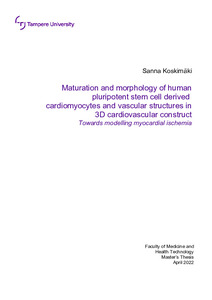Maturation and morphology of human pluripotent stem cell derived cardiomyocytes and vascular structures in 3D cardiovascular construct: Towards modelling myocardial ischemia
Koskimäki, Sanna (2022)
Koskimäki, Sanna
2022
Master's Programme in Biomedical Technology
Lääketieteen ja terveysteknologian tiedekunta - Faculty of Medicine and Health Technology
This publication is copyrighted. You may download, display and print it for Your own personal use. Commercial use is prohibited.
Hyväksymispäivämäärä
2022-05-27
Julkaisun pysyvä osoite on
https://urn.fi/URN:NBN:fi:tuni-202204294175
https://urn.fi/URN:NBN:fi:tuni-202204294175
Tiivistelmä
Cardiac diseases are the leading cause of mortality worldwide. In addition, cardiotoxicity is one of the major reasons for failure in drug development processes. Animal models cannot fully recapitulate the human pathophysiology alongside with high costs and ethical issues. There is an unmet need for 3D in vitro models that can truthfully represent human cardiac tissue, and which could be used for drug development, cardiotoxicity screening, disease modelling, as well as, for basic research. This project is part of the Centre of Excellence in Body-on-Chip research and aims to develop multicellular 3D construct modelling human heart tissue that could be used as a platform for modelling myocardial ischemia.
Human umbilical vein endothelial cells with fluorescent tag (GFP-HUVEC, Cellworks), human adipose stem/stromal cells (hASC) and human induced pluripotent stem cell derived - cardiomyocytes (hiPSC-CM) compose the 3D cardiovascular model. To provide 3D environment, cells are seeded inside and on top of novel hydrazone crosslinked gelatin-gellan gum hydrogel. Characterization methods include qPCR, immunocytochemical staining, and confocal imaging. Additionally, quantitative analysis of beating hiPSC-CMs and formation of vascular structures of HUVECs were conducted.
The results demonstrate that gelatin-gellan gum provides adequate two-parted 3D microenvironment for multicellular heart tissue model. On one hand, the hiPSC-CMs exhibited improved maturation and behaviour comparable to native cardiomyocytes, i.e. elongated morphology and sarcomere structures, as well as alignment with endothelial cells. On the other hand, vascular structures formed in the co-culture, supporting the maturation of hiPSC-CM, but co-culturing did not improve formation of vascular structures when compared to vascular structure alone.
3D cardiovascular model is shown to represent essential characteristics of human cardiac tissue and provides promising platform for modelling human cardiac diseases, such as, myocardial ischemia. In addition, co-culture of hASCs with hiPSC-CM exhibited interesting properties to be used as supportive cells in cardio co-culture and possibly as the only supporting cell type in cardiac co-culture studies.
Human umbilical vein endothelial cells with fluorescent tag (GFP-HUVEC, Cellworks), human adipose stem/stromal cells (hASC) and human induced pluripotent stem cell derived - cardiomyocytes (hiPSC-CM) compose the 3D cardiovascular model. To provide 3D environment, cells are seeded inside and on top of novel hydrazone crosslinked gelatin-gellan gum hydrogel. Characterization methods include qPCR, immunocytochemical staining, and confocal imaging. Additionally, quantitative analysis of beating hiPSC-CMs and formation of vascular structures of HUVECs were conducted.
The results demonstrate that gelatin-gellan gum provides adequate two-parted 3D microenvironment for multicellular heart tissue model. On one hand, the hiPSC-CMs exhibited improved maturation and behaviour comparable to native cardiomyocytes, i.e. elongated morphology and sarcomere structures, as well as alignment with endothelial cells. On the other hand, vascular structures formed in the co-culture, supporting the maturation of hiPSC-CM, but co-culturing did not improve formation of vascular structures when compared to vascular structure alone.
3D cardiovascular model is shown to represent essential characteristics of human cardiac tissue and provides promising platform for modelling human cardiac diseases, such as, myocardial ischemia. In addition, co-culture of hASCs with hiPSC-CM exhibited interesting properties to be used as supportive cells in cardio co-culture and possibly as the only supporting cell type in cardiac co-culture studies.
